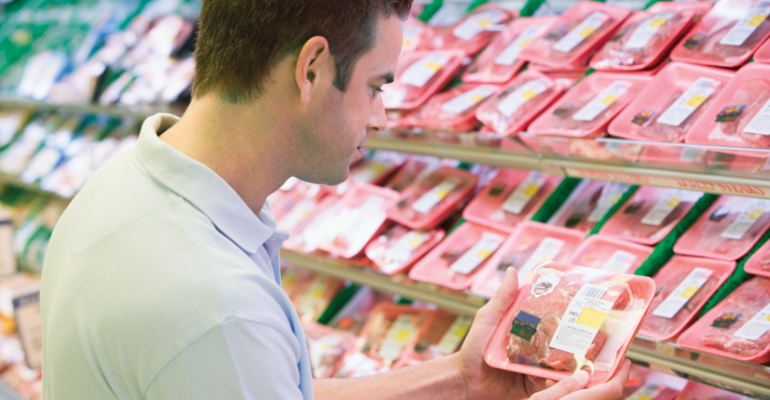While recent reports disagree whether private label meat category sales are growing or staying steady, retailers are enticing shoppers with better marketing and product innovation.
“Where we are seeing the growth continue is with retailers that are really frankly starting to bring to market unique offerings in private label. And the other piece that they’re doing is they are starting to create differentiated products and market them differently,” said Sherry Frey, vice president at Nielsen Perishables Group, about how retailers are achieving private label success across the store.
Research shows private label marketing is especially needed in the meat department.
Midan Marketing’s Power of Brands report found that many of the leading meat store brands weren’t recognized by shoppers either on an unaided or prompted basis.
Hy-Vee gets customers’ attention with a cross-platform approach to marketing. For the launch of its new Angus Reserve brand, the retailer created cooking videos with store chefs that explain how to prepare recipes that incorporate the product, such as a top sirloin stir fry and a grilled ribeye with chili lime marinade and black bean salad.
Hy-Vee also actively advertises its store brands on television, puts recipes with the products on its Pinterest page and samples in-store.
While national brands have traditionally led the way in product innovation, Joe McKie, vice president of private brands at the Food Marketing Institute, said that there are some retailers that excel in this area.
“They have chefs that work for them, and they create products from the ground up. They’re not waiting for the national brands. They’re creating those, I guess, unique and different products that make a difference to that consumer at 3 or 4 o’clock in the afternoon not sure what they are going to do” for dinner.
Hy-Vee does a lot of development work in its test kitchen, said Kurt Johnson, meat supervisor of Hy-Vee’s Southeast Region.
“I think the main difference between what we do and a lot of other companies do is opposed to contacting four or five different companies and saying ‘Here’s what we want. You guys create it and then we’ll have you bid it out and we’ll do it.’ We actually go to that company and develop a line,” he said.
Data Supports Growth
McKie pointed to Wegmans as a leader in fresh food private label offerings.
“If you go into Wegmans you’ll find their fresh side of the business is very highly developed around Wegmans brands, and I’m talking whether you’re in the deli case, whether you’re in the bakery, whether you’re in the meat department.”
Recent industry research shows that branding — either store or national — has an edge in the meat department, according to the Power of Meat Study published by FMI and the American Meat Institute.
Sales were up 1.9% in 2012 for fresh meat national brands, while private brand sales stayed about the same, with a .1% increase, the report found, using Midan Marketing analysis on Freshlook Marketing and Meat Solutions data.
The report also found that consumer preference for national brands was up.

““The economy is ticking up a little bit, and this trend along with several other trends in this report are really driven by your high income folks,” Anne-Marie Roerink, principal at 210 Analytics, the group that prepared the report, told SN about why she thinks national brands are doing better in sales and customers’ minds.
They have a little bit more comfort that their jobs are safe. They have a little bit more disposable income. ... Their household situation might have changed, and so people are starting to move back to the brands, the national brands, the high quality. Quality has always been important for meat and poultry.” Roerink added that national brands have been aggressively marketing their products.
A Nielsen report had different conclusions than the Power of Meat, finding that private label sales growth beat national brands and unbranded in fresh meat and processed meat, just not in the fully cooked meat category, Frey said.
Meat an Exception
In fresh meats, private label sales dollars grew 6.4%, branded grew 5.3% and unbranded grew 2.5%, according to Nielsen’s data.
“The overall growth of store brands across the total store is slowing since the recession; however, there continues to be growth in both private label and brands in the meat department,” Frey said.
Regardless of whether meat private label sales are flat or growing, retailers are continuing to look at changing up their private label product mix.
For instance, Jewel-Osco spokesperson Miguel Alba said the retailer is “evaluating private label meat offerings” in new meat categories. Right now the retailer’s Shoppers Value brand includes fresh sausage and frozen meat, and the meat department mostly offers national brands.
Going forward, Nielsen’s Frey said retailer have the opportunity to differentiate their products in the meat case, noting that the selection of meat products “can be really daunting for consumers.”
Frey suggested that both national brands and private brands work on developing products with multicultural appeal, products for aging customers and products marked as “meals for one” or “meals for two.”
“We have to have not just ‘me too,’ so here’s three types of chicken breasts that frankly have all the same product characteristics. We want to make sure that we’re giving the consumers differentiated products in the case.”





